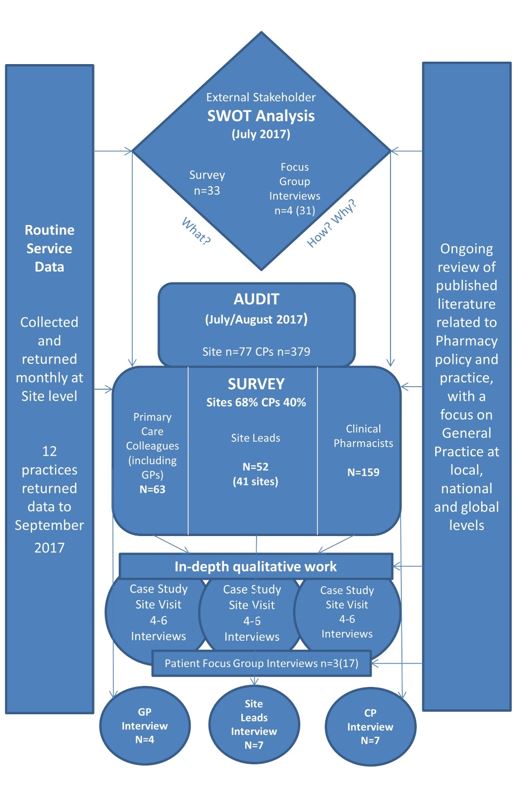Clinical Pharmacists in General Practice: Pilot Scheme Evaluation
In 2016 NHS England published the “General Practice 5 Year Forward View” which outlined an investment of £31million to pilot 470 clinical pharmacists in over 700 practices. This has been supplemented by further central investment of a further £112 million. In doing this NHS England anticipate that this will result in over 2000 clinical pharmacists in general practice by 2020, a ratio of one clinical pharmacist per 30,000 patients.
Pharmacists remain one of the most underutilised professional resources in the system and we must bring their considerable skills in to play more fully.
(GPFYFV)
In this work researchers from the University of Nottingham supported by patient representatives and colleagues form the University of Queensland, Australia have evaluated the pilot phase of this significant investment in pharmacy and general practice.
The research team investigated the work of the newly created pharmacist roles from the perspectives of the pharmacists, those working immediately with them in their roles and high level policy and professional stakeholders and patients. These were evaluated using both qualitative and quantitative methods (see methods figure below). Further in depth case studies were also compiled via site visits.
Project summary diagram

Summary of the evaluation methodology and number of data collected
The evaluation showed that pharmacists increase capacity in patient appointments either through direct face-to-face contact or releasing GP time by taking on tasks ordinarily done by GPs. Pharmacists provided numerous examples of interventions to optimise patient’s medicines and promote safer prescribing.
Patients provided the evaluation team with examples of the benefits of time spent with the pharmacist in the practice including greater understanding of their medicines, improved ability and willingness to take their medicines and a feeling of individual value.
This month I have seen nearly 900 patients and out of those 900 patients, 700 were clinical medication reviews, 150 were long term conditions, 50 were medication reviews, medicine queries, medicine reconciliation, and home visits maybe.
(Senior Clinical Pharmacist Interview, Site C)
The “newness” of the role created some confusion about what pharmacists could and couldn’t do leading to mismatches of expectations, particularly in the early stages of the pilot.
I mean I have only seen [the pharmacist] the once but she spent a lot of time with me, I was in there for 20 minutes. I was impressed with that. I have never had that level of service in this surgery.
(Patient Interview, Site C)
Clinical Pharmacists have made a unique and valuable contribution to the primary care skill mix. Pharmacists contribute significantly to patient safety, bring medicines and prescribing expertise, support with prescribing tasks, support for patients with long term conditions including support for healthy lifestyles
She explained things and spent time with me. It was at least 20 minutes; she went through everything with me and made sure everything was alright with me. Very informative.
(Patient Interview, Site A)
They have improved medication knowledge in the wider clinical team leading to the prospect of overall improvements in care related to medicines.
GP practices expect pharmacists to be able to do more than they could, because they employed pharmacists at band 7 who had no experience, but they expected them to be able to prescribe and to be able to do all these things on day one, which they couldn’t.
(Pharmacist SWOT analysis focus group)
This evaluation was funded by NHS England.